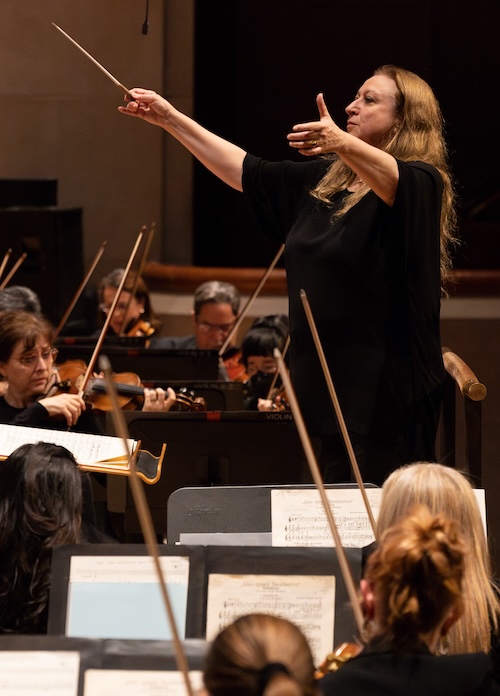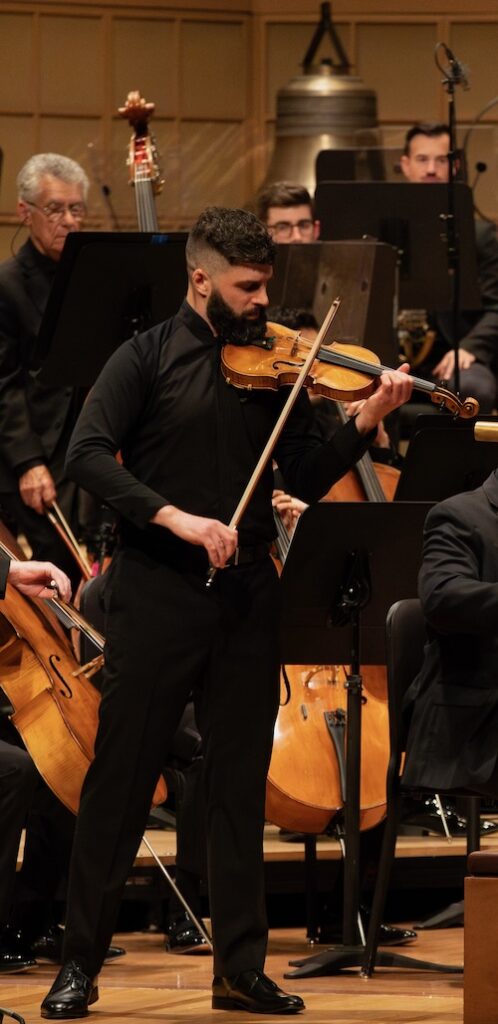Young leads Dallas Symphony in music of questioning, contemplation

The Dallas Symphony Orchestra concert on Thursday night under the baton of guest conductor Simone Young presented music on contemplative subjects: Cantus in Memoriam Benjamin Britten by Arvo Pärt followed by Britten’s own Violin Concerto and concluding with Also Sprach Zarathustra by Richard Strauss.
Guest conductor Young is currently the principal conductor of the Sydney Symphony Orchestra, having held that position since 2020.
Pärt’s Cantus is scored solely for string orchestra augmented by a reiterating bell.Beginning with the soft bell tones, a descending string figure sounding over a drone punctuated by occasional bass notes produced an initially hypnotic stasis that Young shaped with gradually increasing dynamics until the sound enveloped the audience. At this point, a set of more assertive tones in the bass register abruptly provided a new harmonic contrast for the drones. With the piece’s reverie thus disturbed, the dynamic process reversed itself rather quickly, creating an overall atmosphere of intense solemnity but without a peaceful conclusion.
Britten’s Violin Concerto also offered passages of contemplative ambiance. Britten’s desire to memorialize the fallen Republican veterans of the Spanish Civil War was a influence and Britten included rhythms and harmonies that reflect this Iberian inspiration. His addition of dissonance disturbs the otherwise exotic sounding sonorities and his inclusion of militaristic rhythms and percussion imbues the music with a sense of futility and fatalism.
As the violin soloist, DSO co-concertmaster Nathan Olson proved an effective solo protagonist, alternating between a fervent singing tone that reflects the somber mood and brisk dance gestures that try but fail to escape the angst. Young’s assertive presence on the podium mirrored these characterizations, with her gestures prompting the appropriate playing from the orchestra.

The second movement, Vivace, took on an oppressive, military ambiance that dashed the faint optimism of the movement’s opening. The cadenza that followed suggested a lyrical remembrance of everything that had come before, due largely to recollections of themes from the first movement as well as the persistence of rhythms and gestures evoking Spanish styles. Despite the use of special techniques such as a particularly high register and left hand pizzicato, Olson’s part acted more as an expressive contribution to the whole rather than a technical showpiece.
The passacaglia finale proceeded through a series of episodic variations that continued to explore the Spanish, dance-like, and militaristic topics already presented. After building to a climax, the orchestra under Young appeared headed to a conclusion, sounding a series of triadic harmonies under Olson’s embellished reiterations of the opening theme. The ending, with Olson trilling F natural and F sharp over a D major sonority in the ensemble, provides no real resolution, perhaps reflecting a sense of overall ambivalence. Despite the unflashy ending both Young and Olson were called back twice to receive the standing applause of the audience.
Richard Strauss’s tone poem, Also Sprach Zarathustra made up the second part of the program. One can imagine any conductor finding a challenge in finding a fresh take on this familiar piece, particularly the opening bars. Young easily met this challenge, presenting this segment not like the swaggering introduction to a space opera, but instead evoking the Sunrise in the prologue of Nietzsche’s original by smoothly connecting the notes of each opening fanfare gesture and shaping each of these with an even crescendo.
Her direction of the rest of the piece followed a similar course. Segments such as “Of the Backworldsmen,” with its rich string orchestration and melancholy sentiment, and “Of Joys and Passions,” with its agitated rhythms and harmonies, are steeped in 19th century musical rhetoric that can easily sound clichéd with a minimum of exaggeration. Young was careful to reign in these qualities without restraining the music, allowing the sentiments to sound fresh. Similarly, her treatment of the fugue based on the opening fanfare evoking the sunrise was rhythmically supple without being slack.
Extensive divisions in the strings during the last two segments, “Dance Song” and “Song of the Night Wanderer” added sumptuousness to the overall texture, but yet still allowed the solo parts—taken by principals Emmanuelle Boivert, Eunice Keem, Meredith Kufchak and Christopher Adkins—to come through clearly. The brass section was a cornerstone throughout, adding not just power, but also the distinct brass timbres that both stood and yet blended well with the rest of the group. The same was true of the wind section, marked particularly by the dexterous clarinets and the agile piccolos.
The conclusion of Also Sprach Zarathustra belies its spectacular opening; the piece concludes pianissimo with its own unresolved harmony in the form of B major sonorities in the upper voices contrasting with almost inaudible references to C major in the cellos and basses. This unresolved codalinks this piece conceptually with the preceding pieces by Pärt and especially Britten, both of which feature their own questioning endings
The program will be repeated 7:30 p.m. Friday and Saturday and 3 p.m. Sunday. dallassymphony.org